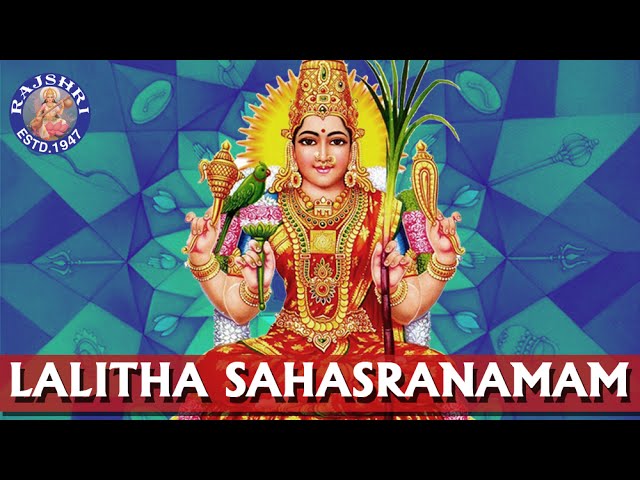Lalitha Sahasranamam PDF
Sahasranamam means a ‘thousand names,’ and Lalitha is the name of the Hindu mother goddess. It’s a Hindu text written in Sanskrit derived from the Brahmanda Purana (history of the universe). Goddess Lalitha Devi is an embodiment of the Divine Mother (Shakti). The text Lalitha Sahasranamam is the fundamental text of Shakti Worshiper, therefore used in the worship of Durga, Parvati, Lakshmi, Kali, Bhagavati, and so on. This sahasranama is used in various ways to worship the Divine Mother, including parayana (recitations), Archana, and homa. According to the Sahasranama, Lalita can only be worshiped if she asks us to.
Lalitha Sahasranamam in English PDF
Lalitha-Sahasranama-StotramLalitha Sahasranamam pdf Telugu
sri-lalitha-sahasranamam-teluguLalitha Sahasranamam Tamil pdf
lalitha-sahasranamam-tamilComposition
By the commandment of the goddess herself, the Lalitha Sahasranamam has been composed by eight Devis, namely- Vasini, Kameshvari, Aruna, Vimala, Jayani, Modini, Sarveshvari, and Kaulini. The names are structured as hymns or stotras. However, they are frequently broken down into mantras to symbolize all 1000 names. As a result, the Sahasranama can be sung in either stotra or namavali form.
The Lalita Sahasranama is structured to describe Devi from “Head to Toe” (Kesadi Padam). The names then laud the Devi in her accomplishments, powers, and forms. The text goes into great length detailing the physical characteristic of the goddess.
The names go into great detail, describing Lalitha’s utmost beauty. The mantras depict her beauty as the ideal feminine form and describe her splendor as unmatched to any other celestial. It describes her hair as dark, thick, and long, adorned with flowers like Champaka, Ashoka, Saugandha, etc. Her eyebrows are gorgeous compared to the arch gates of Kamadeva’s residence, and on her forehead, she has a musk Tilak. Her cheeks shine brighter than the Padmaraga; her voice sounds sweeter than the Veena of Saraswati.
Etymology
Lalitha’s etymology is “She Who Plays.” The word Lalitha means “spontaneous” in its base form, which derives the connotation “easy” and implicitly extends to “play.”
The verses of Sahasranamam generally use some conjunctions like tu, api, ca, and hi but don’t use any auxiliary conjunctions. These conjunctions do not carry any meaning in particular, but they are necessary in interpretation cases.
Concepts
Dhyanam
Dhyanam is the starting point of Lalitha Sahasranamam. There are a total of four descriptive verses which depict many forms and qualities of the goddess. It describes the Yogi (the person who recites mantras or sacred texts) as focusing on the appearance of Lalita and describing several of the goddess’s attributes.
There is a constant theme in all of the dhyana verses about Devi’s red complexion, which resembles the sun at dawn, and her sympathetic character. The Dhyanam is recited before chanting the “thousand names.” The four verses are as follows:
Verse 1
“Sindhuraruna vigraham trinayanam manikya mouli spurath
Thara Nayaga sekaram smitha mukhi mapina vakshoruham,
Panibhayam alipoorna ratna chashakam rakthothpalam vibhrathim,
Soumyam ratna gatastha raktha charanam, dhyayeth paramambikam.”
The verse is composed by the “Eight Vaag Devis.” Interpretation of the verse is as follows:
Meditate on that, Ambika
Who has a body of the color of saffron,
Who has the three graceful eyes,
Who has a jeweled crown,
Adorned by the moon,
Who always has a captivating smile,
Who has high and firm breasts,
Who has wine-filled cup made of precious stones,
And reddish flowers in her hands,
Who forever is the ocean of peace,
And who keeps her red holy feet.
On a jeweled platform.
Verse 2
”Arunam Karuna thrangitakshim dhrutha –pasangusa-pushpabana-chapam,
Animadhibhi-ravrutham mayukai –raha mityeva vibhavaye Bhavanim.”
This verse is composed by “Dattatreya,” and the interpretation goes as follows:
I imagine of my goddess Bhavani,
Who has a color of the rising sun.
Who has eyes which are waves of mercy,
Who has bow made of sweet cane,
Arrows made of soft flowers,
And pasanugusa in her hands,
And who is surrounded,
By her devotees with powers great,
As personification of the concept of “aham”
Verse 3
“Dyayeth padmasanastham vikasitha vadanam padma pathrayathakshim,
Hemabham peethavasthram karakalitha-lasadhema padmam varangim,
Sarvalangara yuktham sathatham abhayadam bhaktha namram bhavanim.
Srividyam santhamuthim sakala suranutham sarva sampat pradhatrim.”
The origin of the third verse is unknown.
Meditate I do,
On her who sits on a lotus,
On her who has a smiling face,
On her who has long eyes like the lotus leaf,
On her who glitters like gold,
On her who wears red cloths,
On her who has a golden lotus in her hand,
On her who grants all desires,
On her who is dressed with perfection,
On her who gives protection,
On her who has soft heart to her devotees,
On her who is Sri vidya,
On her who is forever peaceful,
On her who is worshipped by gods,
And on her who gives all wealth.
Verse 4
Sakumkumalepana –malikachumbi-Kasthurikam,Samanda hasithekshanam sashra chapa pasangusam,Asesha jana mohinim –maruna malya bhoosham bara,Japa-kusuma-basuram japa vidhou smarathembikam.
This verse was composed by Adi Sankaracharya. Meaning of the verse-
Meditate on her,
Who applies saffron on her body,
Who applies musk attracted by bees on her,
Who has a beautiful smile,
Who has with her bows, arrows and Pasangusa,
Who attracts all the souls,
Who wears red garland,
Who wears ornaments great,
And who is of the colour of the red hibiscus,
The Sahasranamas or the thousand names of the goddess Lalitha, defines her entirely as a celestial being. The names depicts her beauty, her belevolence, her might, and so on. These names are used for worshipping the Hindu mother goddess Lalitha.
